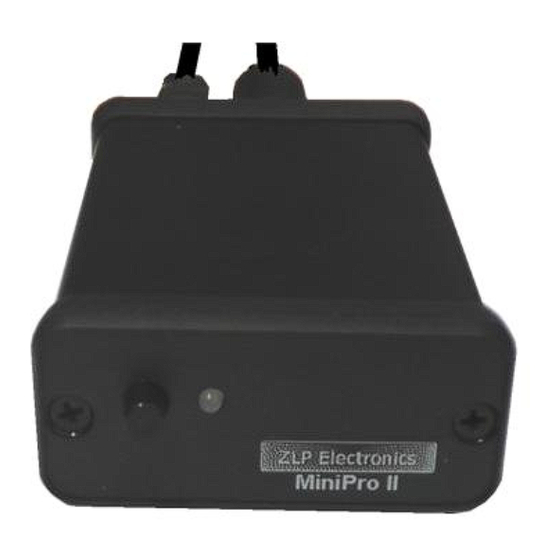
Subscribe to Our Youtube Channel
Summary of Contents for ZLP Electronics MiniProSC
- Page 1 MiniProSC Hi performance Digital DATA mode interface Built in hi quality low noise Texas Instruments USB audio codec. Compatible with ALL afsk DATA modes and ALL afsk DATA software.
-
Page 2: Installation Is Now Complete
Installing the MiniProSC Simply plug in to the rear of the interface and into a powered USB port, if you use a hub ensure that it is a powered hub. Windows will detect and automatically install the drivers for the Texas Instruments Audio Codec chip. -
Page 3: Configuring Your Software
Configuring your software. To configure your software to use the Interface you simply select the appropriate audio codec as the soundcard device to use. If you have more than one interface with audio codec Windows will number them for you. You do not need to configure anything for the PTT as the interface will generate PTT automatically for you whenever your software generates tones for transmission. - Page 4 Press F8 (program options) and select “soundcard”, simply select the soundcard from the list of soundcards. You should now adjust your I/O levels. You can often do that in your software (as shown below when using DM780) or you can always do it through Windows volume control / mixer.
- Page 5 Set your levels in Windows. The soundcard settings can be adjusted in Windows or in some software (inc HRD) from the window where you select your soundcard. In HRD, simply click the button “...” below the input Device and the following window will open;...
- Page 6 Double click the “Microphone option”; Then select the “Levels” Tab; And adjust the INPUT level as appropriate.
- Page 7 To adjust the OUTPUT level Note that the PTT is derived from the right hand channel and that the Audio-DATA is derived from the left hand channel. Reducing the output level too far may result in unreliable PTT. If you need to reduce the drive level to such an extent that PTT becomes unreliable; then you should instead, reduce the drive level by use of the balance control.
- Page 8 Select the “Levels” Tab; Adjust the Speakers as appropriate, normally set to 90-100% IMPORTANT TO MUTE the Microphone here, this is NOT the same microphone used for input. This microphone is used to sample the output from the speakers and you may not achieve correct results if you do not mute this input.
- Page 9 Setting the default soundcard. You may wish to set your original soundcard as the “default” soundcard and this will prevent Windows system sounds from activating the interface. This is done via standard Windows configuration. Open Windows “Volume Mixer”. The contents of the Window will depend on what software you have running.
- Page 10 Click on the tab “Playback”;- Click on the soundcard you wish to use for system sounds then click the button “Set Default”. System sounds are now configured to be played back through your normal speakers while your DATA software will use the audio codec. There are other ways to go through the Windows process to achieve the same results.
- Page 11 In case of problems LED switches from GREEN to RED when operating software to TX. Some radios may go into TX but send no DATA. Some radios will not go into TX. Some radios such as Icom 706 require baud rate to be set at 1200. This selects the appropriate pin on the 6 pin DATA socket for PTT (1200 rather than 9600).
- Page 12 DigiMaster 6 pin mini din socket. NOTE: This is the “common” connection to all DigiMaster DATA interfaces. The MiniProSC does not support fsk and so there is no fsk connection.



Need help?
Do you have a question about the MiniProSC and is the answer not in the manual?
Questions and answers